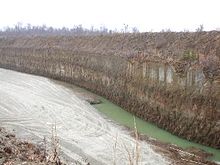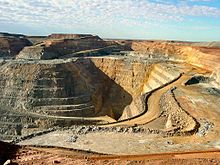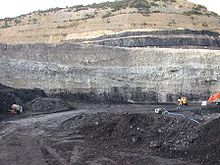- Open-pit mining
-
Open-pit mining or opencast mining refers to a method of extracting rock or minerals from the earth by their removal from an open pit or borrow.
The term is used to differentiate this form of mining from extractive methods that require tunneling into the earth. Open-pit mines are used when deposits of commercially useful minerals or rock are found near the surface; that is, where the overburden (surface material covering the valuable deposit) is relatively thin or the material of interest is structurally unsuitable for tunneling (as would be the case for sand, cinder, and gravel). For minerals that occur deep below the surface—where the overburden is thick or the mineral occurs as veins in hard rock—underground mining methods extract the valued material.
Open-pit mines that produce building materials and dimension stone are commonly referred to as quarries. People are unlikely to make a distinction between an open-pit mine and other types of open-cast mines,[citation needed] such as quarries, borrows, placers, and strip mines.
Open-pit mines are typically enlarged until either the mineral resource is exhausted, or an increasing ratio of overburden to ore makes further mining uneconomic. When this occurs, the exhausted mines are sometimes converted to landfills for disposal of solid wastes. However, some form of water control is usually required to keep the mine pit from becoming a lake.
Contents
Extraction
Open-pit mines are dug on benches, which describe vertical levels of the hole. These benches are usually on four metre to sixty metre intervals, depending on the size of the machinery that is being used. Many quarries do not use benches, as they are usually shallow.
Most walls of the pit are generally dug on an angle less than vertical, to prevent and minimise damage and danger from rock falls. This depends on how weathered the rocks are, and the type of rock, and also how many structural weaknesses occur within the rocks, such as a fault, shears, joints or foliations.
The walls are stepped. The inclined section of the wall is known as the batter, and the flat part of the step is known as the bench or berm. The steps in the walls help prevent rock falls continuing down the entire face of the wall. In some instances additional ground support is required and rock bolts, cable bolts and shotcrete are used. De-watering bores may be used to relieve water pressure by drilling horizontally into the wall, which is often enough to cause failures in the wall by itself.
A haul road is usually situated at the side of the pit, forming a ramp up which trucks can drive, carrying ore and waste rock.
Waste rock is piled up at the surface, near the edge of the open pit. This is known as the waste dump. The waste dump is also tiered and stepped, to minimise degradation.
Ore which has been processed is known as tailings, and is generally a slurry. This is pumped to a tailings dam or settling pond, where the water evaporates. Tailings dams can often be toxic due to the presence of unextracted sulfide minerals, some forms of toxic minerals in the gangue, and often cyanide which is used to treat gold ore via the cyanide leach process. This toxicity has the potential to negatively impact on the surrounding environment.
Rehabilitation
After mining finishes, the mine area must undergo rehabilitation. Waste dumps are contoured to flatten them out, to further stabilise them. If the ore contains sulfides it is usually covered with a layer of clay to prevent access of rain and oxygen from the air, which can oxidise the sulfides to produce sulfuric acid, a phenomenon known as acid mine drainage. This is then generally covered with soil, and vegetation is planted to help consolidate the material. Eventually this layer will erode, but it is generally hoped that the rate of leaching or acid will be slowed by the cover such that the environment can handle the load of acid and associated heavy metals. There are no long term studies on the success of these covers due to the relatively short time in which large scale open pit mining has existed. It may take hundreds to thousands of years for some waste dumps to become "acid neutral" and stop leaching to the environment. The dumps are usually fenced off to prevent livestock denuding them of vegetation. The open pit is then surrounded with a fence, to prevent access, and it generally eventually fills up with ground water. In arid areas it may not fill due to deep groundwater levels.
Typical open cut grades
Gold is generally extracted in open-pit mines at 1 to 2 ppm (grams per tonne) but in certain cases, 0.75ppm gold is economical. This was achieved by bulk heap leaching at Alkane Minerals Ltd. Peak Hill mine in western New South Wales, near Dubbo, Australia.
Nickel, generally as laterite, is extracted via open-pit down to 0.2%. Copper is extracted at grades as low as 0.15% to 0.2%, generally in massive open-pit mines in Chile, where the size of the resources and favorable metallurgy allows economies of scale.
Materials typically extracted from open-pit mines include:
- Clay
- Coal
- Coquina
- Diamonds
- Gravel and stone (stone refers to bedrock, while gravel is unconsolidated material, as found in glacial or fluvial deposits)
- Granite
- Gritstone
- Gypsum
- Limestone
- Marble
- Metal ores, such as copper, iron, gold, and molybdenum
Open-pit mines
This list includes only those large open-pit mines for which an article exists in Wikipedia.
Argentina
- Cerro Vanguardia Mine; gold and silver mine located near Puerto San Julián, Santa Cruz.
- Pascua Lama – binational gold and silver mine in San Juan, Argentina and Atacama, Chile (in project).
Australia
- Super Pit – gold mine near Kalgoorlie, Western Australia.
- Cadia mine – gold and copper mine located near Orange, New South Wales.
- Boddington Gold Mine – Boddington, Western Australia.
- Telfer Mine – Gold and copper mine in Pilbara, Western Australia
- Ranger Mine – Uranium mine east of Darwin in the Northern Territory, Weipa, Queensland
Bulgaria
- Maritsa Iztok Mines – coal mine near Radnevo, Stara Zagora Province, Bulgaria.
Canada
- Adams Mine – abandoned mine in Kirkland Lake, Ontario.
- Sherman Mine – abandoned iron mine in Temagami, Ontario.
- Colomac Mine – gold mine in Northwest Territories.
- Diavik Diamond Mine – diamond mine in Northwest Territories.
- Ekati Diamond Mine – diamond mine in Northwest Territories.
- Pine Point Mine – lead and zinc mine in Northwest Territories.
Chile
- Chuquicamata – copper mine.
- Escondida – copper mine.
- Pascua Lama – binational gold and silver mine in San Juan, Argentina and Atacama, Chile (in project).
- Radomiro Tomic – copper mine.
Colombia
- Cerrejón – coal mine in Guajira Department.
Egypt
- Sukari gold mine
Germany
- Tagebau Garzweiler – lignite mine.
- Tagebau Hambach – lignite mine.
Indonesia
- Batu Hijau mine – copper and gold mine on the island of Sumbawa.
- Grasberg mine – located in the mountains of the Papua province.
Kyrgyzstan
- Kumtor Gold Mine – gold mine in Tian Shan Mountains at 4,000-4,400 m (14,000 ft) above sea level.
Mongolia
- Boroo Gold Mine – gold mine 110 km (70 mi) WNW of the capital Ulan Bator.
Namibia
- Rossing – uranium mine.
Peru
- Yanacocha – gold mine.
- Toquepala – Porphyry copper.
Portugal
- Sao Domingos Mine – copper mine.
Romania
- Berbeşti Coal Mine – coal mine.
- Motru Coal Mine – coal mine.
- Rovinari Coal Mine – coal mine.
Russia
- Mirny Mine − diamond mine in Mirny, Eastern Siberia
- Udachnaya pipe − diamond mine in Yakutia, Russia.
South Africa
- The Big Hole, a former diamond mine in Kimberley, dug to 240 m (790 ft) between 1871 and 1914, making it the deepest hand-excavated pit in the world. Now a museum.
- The Jagersfontein Mine, operating between 1888 and 1971. This was hand-excavated to 201 m (660 ft) by 1911, and the hand-dug pit was sightly larger than the Big Hole.
Spain
- Corta Atalaya is the largest open-pit mine in Europe[1] and was at one time the largest in the world.
- Sierra Menera, Sistema Ibérico
Sweden
- Aitik-gruvan in Gällivare, copper mine with side production of gold and molybdenum.
United Kingdom
- Penrhyn Quarry – slate quarry in Wales.
United States
- Berkeley Pit - former copper mine in Butte, Montana; now a toxic lake and tourist attraction.
- El Chino Mine – copper mine in Grant County, New Mexico.
- Hull-Rust-Mahoning Mine – largest open pit iron mine in the world near Hibbing, Minnesota.[citation needed]
- Bingham Canyon Mine – copper mine in Salt Lake County, Utah.
- Lavender Pit – copper mine in Cochise County, Arizona.
- Cresson Mine – a gold mine in Victor, Colorado.
- Red Dog mine – a zinc and lead mine in Red Dog Mine, Alaska.
Zambia
- Nchanga Open Pit Mine, Chingola. The second largest open cast mine in the world,[2] covering nearly 30 km² and up to 400m deep.
See also
- Bagger 288, an enormous piece of pit-mining equipment
- Cut-and-cover
- Cut (earthmoving)
- Trench
References
- ^ (Spanish) Emed Mining gestiona reapertura al turismo de Corta Atalaya en mina Riotinto, eleconomista.es, 2007-12-09. Accessed online 2010-01-06.
- ^ "Second Largest Open Cast Mine". Times of Zambia. http://www.times.co.zm/news/viewnews.cgi?category=8&id=1193485069. Retrieved 2009-01-28.
External links
- The biggest, deepest and deadliest mines in the world
- Basics of an open pit mine
- Large Surface Miners
Mining techniques Surface Sub-surface Categories:
Wikimedia Foundation. 2010.










